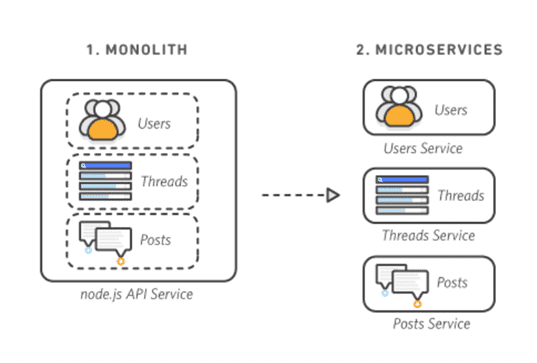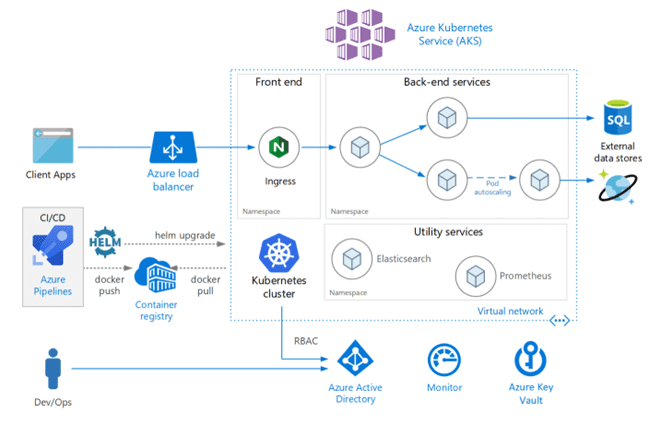Over the past decade, organizations have reinvented themselves through digital transformation. Nowadays, this journey is well in its second chapter and gaining momentum – also driven by the explosion of app and service deployment, data and intelligence, digital reach, and post-pandemic customer expectations.
And the newest cutting-edge technological trends – such as hybrid infrastructure and edge computing – are making it particularly difficult for traditional tools to keep up.
Specifically, microservices are on the rise.
According to IDC, 90% of all apps will feature microservices architectures by 2022. And combined with agile/DevOps approaches and methodologies, enterprises can dramatically accelerate their ability to push out digital innovation – at 50-100x the frequency of traditional techniques.
So whether you’re a developer or a tech enthusiast, here’s the 101 on microservices.
Question 1: What are Microservices?
AWS defines microservices as “an architectural and organizational approach to software development where software is composed of small independent services that communicate over well-defined APIs. These services are owned by small, self-contained teams.”
Source: AWS
And microservices came about due to specific limitations of their predecessor – the monolith.
The original monolith had the web and application servers, business functions, and database all on one system. But over time, the database became a resource hog.
So architects moved the monolith’s data storage mechanisms to a separate machine private to the network. But then the application logic started pushing the limits of the host’s computing capacity.
So architects implemented a multiple instance design in which many computers hosting identical business logic were put behind a load balancer (to route traffic). But when a change needed to be made, the entire application needed to be taken offline, updated and tested.
It turned out that replicating the monolith was not the scalable solution developers needed.
And that’s how microservices – or independent units of computing – were born.
Question 2: What are the Key Advantages of Microservices?
Overall, microservices make applications easier to scale and faster to develop, enabling innovation and accelerating time-to-market for new features. This architecture helps businesses reduce downtime, optimize resources, and decrease infrastructure costs.
Advantage 1: Scalability and agility
With a microservices architecture, each service can be scaled independently without having to scale the entire application.
Plus, any update or feature can be deployed separately without affecting the entire application. So if a delivery goes wrong for a single service, it can easily be called off without hampering the operations of the entire application.
Advantage 2: Feature Independence
Microservices allow for teams to work on separate services, overall resulting in quicker and cheaper deployments.
Additionally, microservices allow developers to use the right technology for each service (whether it’s the one best suited for the particular service or the one that the developer is most comfortable with).
Lastly, with a smaller codebase, there is less risk of code entanglement.
Advantage 3: Optimized Testing
With abstracted endpoints, testing becomes easier. Automated Deployment can be combined with Automated Testing (e.g. Continuous Testing).
Also, coupling microservices with DevOps results in an agile environment with important benefits: it improves test cycle times and empowers independent development teams.
Overall, given that each service is independent, the maintenance of microservices is simpler. Resilience patterns – whether circuit breakers or bulkheads – can isolate anomalies more quickly than in monolithic architecture.
Question 3: What are the Key Disadvantages of Microservices?
Microservices aren’t free of shortcomings. Developing a microservices architecture is far more complicated than a monolithic one so execution and implementation can present challenges.
Disadvantage 1: Complexity
With multiple moving parts, maintaining the architecture as a whole can become tricky. For example, instead of monitoring one whole application, each service must be monitored and orchestrated independently of one another. Also, the architecture lends itself to data inconsistencies that might take a considerable time for business stakeholders or engineers to detect and reconcile.
In addition, the interaction between different services can become challenging as the overall infrastructure communication becomes complex. This happens in particular when handling requests flowing between each service. Potential different technologies within the same application accentuate these inter-operational processes and communication even further.
Disadvantage 2: Debugging, Testing & Security
While identifying bugs might be easier with isolated node failures, developers will still have to go through the logs of each service.
Further, testing service dependencies can become a challenge, especially if the application is evolving quickly.
And the higher number of individual parts unfortunately means a higher risk of hacker attacks.
Disadvantage 3: Setup Challenges
The success of a microservices implementation heavily depends on the when, how, and why.
Microservices work best for organizations that have adopted mini services, agile DevOps, and continuous delivery practices, but still aren’t able to achieve their software engineering cadence goals.
Also, for ultimate success, supporting operational processes would need to be put in place (e.g. an optimized operating model and team structure).
Plus, organizations should not implement microservices if they’re trying to cut down on costs. Microservices typically cost more to implement than a monolithic architecture.
Question 4: What are the Key Trends Shaping Microservices Development?
Several enabling trends are arising that will be shaping the microservices landscape in the years to come.
Trend 1: Artificial Intelligence Operations (AIOps)
Gartner defines Artificial Intelligence Operations as combining “big data and machine learning to automate IT operations processes, including event correlation, anomaly detection, and causality determination.”
AI Ops can analyze large amounts of data to identify existing and anticipate future problems.
Trend 2: Serverless Computing
As an event-based application design and deployment model, serverless computing delivers computing resources as scalable cloud services. In a serverless deployment, the cloud customer only pays for the services consumed (never for inactivity or downtime).
Trend 3: Kubernetes
Question 5: Are Observability and Monitoring Important in Microservices?
Even the most experienced development teams cannot predict all of the possible scenarios that could bring down their microservices applications. Thus, the ability to detect and address anomalies in real-time and quickly is critical. And this is where observability and monitoring come into play.
Observability (logs, metrics, and traces) in microservices allows developers to have access to the relevant data to identify anomalies and detect failures. Since microservices can span multiple systems, manually tracing the source of a failure becomes a time-consuming (and possibly impossible) task.
On the other hand, monitoring tracks performance and identifies both problems and anomalies, but with a focus on qualitative information. In a nutshell, it describes the benchmarked health, performance, and efficiency of the internal state. With microservices, it’s critical to understand all of the various calls to each service as well as map out the monitoring responsibilities for each of the relevant teams. Team members should know what failure they’re responsible for.
Conclusion
As software has emerged as a critical differentiator in almost every industry, some of the biggest global enterprises have had to make radical changes in how they build and deliver software.
Accordingly, microservices have increased in popularity due to their many advantages: from increased agility and organizational scale to cost-effective scaling and developmental efficiency.
It comes as no surprise then that Amazon, Uber, Airbnb, Netflix, Yelp, and many other powerhouses have adopted microservices. And according to O’Reilly, 92% of adopting organizations are already experiencing success with it.
Plus, many engineering leaders believe that if they don’t adopt microservices, they will die from competition moving faster.
So with the incredible momentum in microservices adoption, the effort around adopting it will only continue to shrink over time.






